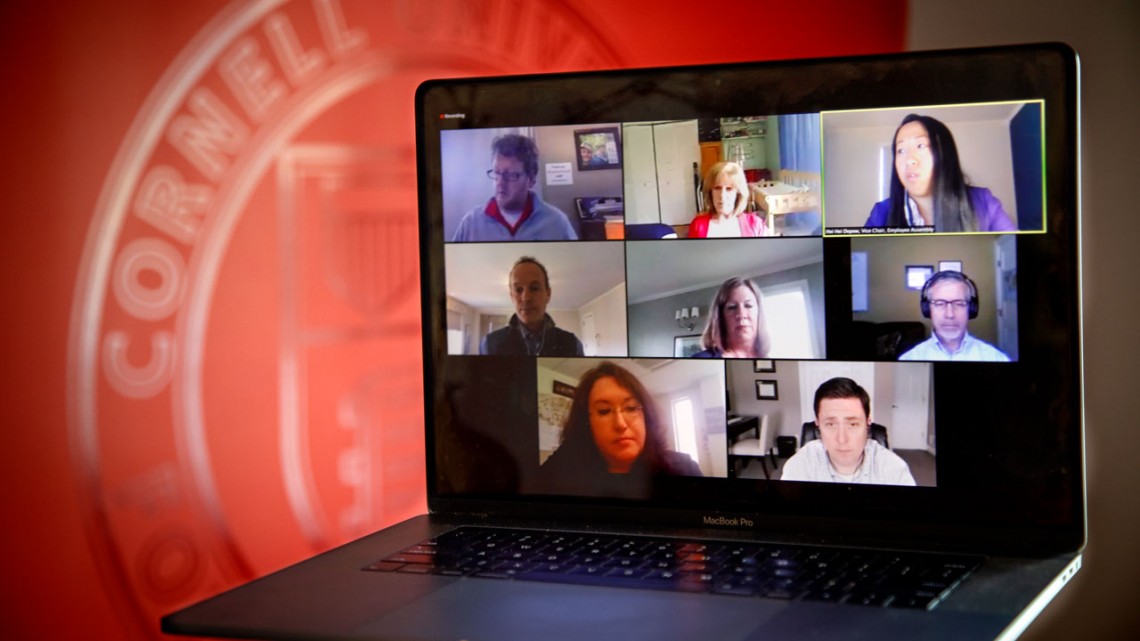
Cornell leaders hold a virtual staff forum April 29.
As infections slow, leaders plan for reopening campuses
By James Dean
University teams are assessing options for safely reactivating Cornell’s campuses amid encouraging signs that COVID-19 infection rates are falling nationally and in New York state, senior leaders said April 29 during a virtual staff forum sponsored by the Employee Assembly.
Public health strategies – including staying at home, social distancing and quarantines – appear to be slowing the virus’s spread, said Dr. Anne Jones ’04, director of medical services for Cornell Health.
“That’s a great glimmer of hope for us,” she said.
Hope is welcome following the unprecedented disruptions to campus operations over the past nearly two months, and in the face of challenging budget deficits presented by the coronavirus pandemic.
In an April 22 message to the Cornell community, President Martha E. Pollack announced that four planning committees comprising faculty, staff and students would develop recommendations about when and how the university could resume instruction and research on campus.
“We remain hopeful that, working with public health and other scientific experts, we will be able to resume campus operations and welcome students back to our campuses for the start of the fall semester; however, it is simply too soon to make that guarantee,” Provost Michael I. Kotlikoff said in an April 30 update to the community.
Summer classes have been moved online or canceled, and committee recommendations about the fall semester are expected by the end of June.
“We need to understand what are the various concerns and possibilities, and how can we then establish various reopening parameters to minimize, if not completely erase, those potential setbacks,” said Joel Malina, vice president for university relations.
Cornell leadership will support New York state’s broader recovery. Gov. Andrew Cuomo on April 28 asked Pollack to serve on his New York Forward Reopening Advisory Board. Provost Michael I. Kotlikoff will co-chair another advisory board focused on the higher education sector.
Malina and Emmanuel Giannelis, vice provost for research and vice president for technology transfer, intellectual policy and research policy, are working with local government, health, business and nonprofit leaders in Tompkins County.
Public health experts have identified several criteria that should guide local and regional planning, Jones said: having reduced disease counts for an extended period; health systems with adequate staffing and personal protective equipment; and capacity to perform rapid testing and comprehensive contact tracing as part of a “test and isolate” approach.
Communities, Jones said, should think not in terms of pandemic recovery but “pandemic resilience.”
No reopening strategy will be entirely free of risk, said Rick Burgess, vice president for facilities and campus services.
“We and many others are trying to figure how to lower the risk to the point where it’s reasonable,” he said. “This is really all about smart risk and smartly balancing things.”
Among the many possibilities committees are looking at, the leaders said in response to questions, are a potential phased approach to returning students to campus and ways classrooms might be reconfigured to accommodate social distancing.
Despite uncertainty about the fall, housing deposits from newly admitted students – a key barometer of their intention to attend Cornell – are trending ahead of previous years, said Ryan Lombardi, vice president for student and campus life.
While that planning progresses, the university must confront a projected budget shortfall of $160 million to $210 million by the end of the next fiscal year, totals that anticipate a sharp increase in the need for financial aid. In her statement, Pollack said the outlook would worsen if the university were unable to fully reopen this fall, and has charged one committee with identifying potential cuts of up to 5%, 10% and 20% across the university.
“We can’t wait to find out if we have a worst case to do worst-case scenario modeling,” said Joanne DeStefano, executive vice president and chief financial officer. “The more we talk to all of you, the better ideas [we get], and the more we can fine-tune what our real strategy is going to be to solve our budget problems. … We will be a stronger university in the end.”
The university expects to receive $12.8 million from the federal CARES Act, legislation that provided emergency relief to colleges and universities across the country according to a formula that weighed their overall size and numbers of low-income students, Malina said. All of those funds, he said, would go to support students with financial need.
Cornell has announced salary and hiring freezes and voluntary pay cuts by senior administrators and some faculty and staff, and a pause in construction projects. (The North Campus Residential Expansion, Burgess said, has been cleared to resume). Pollack said additional cost-saving measures “almost certainly” would include furloughs or layoffs, though the university was doing everything possible to protect staff.
Mary Opperman, vice president and chief human resources officer, said the university has furloughed “a very limited number” of employees so far and ended or not renewed some temporary appointments.
“The well-being of the staff has remained absolutely at the forefront of every conversation,” Opperman said. “As we decide what to do, we are testing each and every strategy against the impact it has on our people.”
While prudently preparing for the worst, the leaders said they are grateful to now be in a position to plan for a return to campus operations and activities.
“Even though coming back to full operations will be challenging,” Opperman said, “it’s such a hopeful sign that we’re beginning to plan.”
The virtual staff forum on Zoom drew nearly 3,000 participants. Replays and transcripts of the April 29 forum and three earlier ones – on March 18, March 25 and April 1 – are available online.
Answers to many questions and links to information are available on the university’s Novel Coronavirus (COVID-19) Resources and Updates and COVID-19: Workplace Guidance pages.
Media Contact
Get Cornell news delivered right to your inbox.
Subscribe
